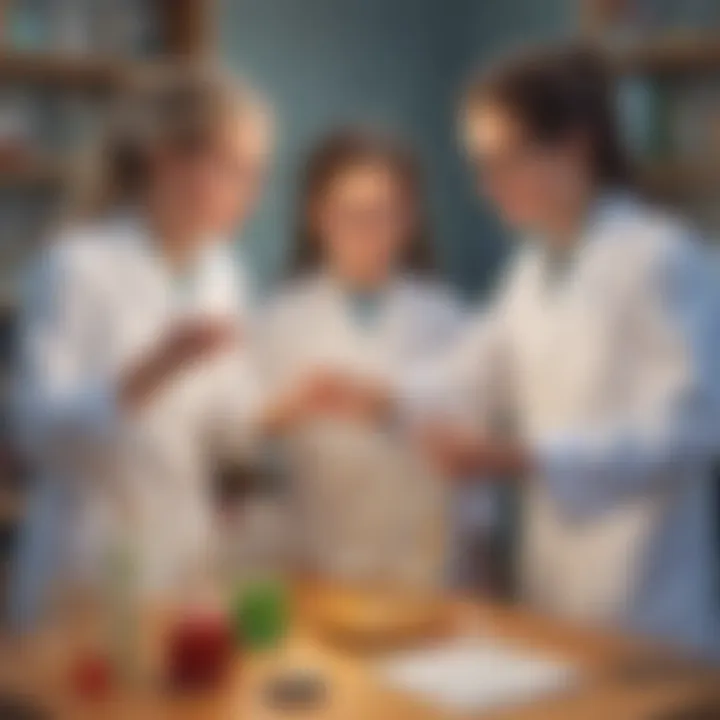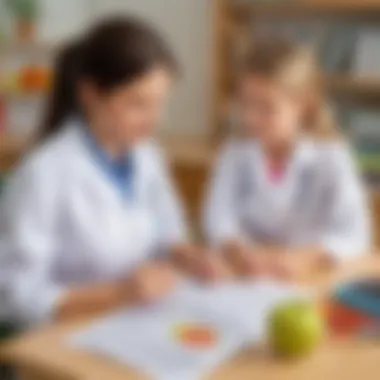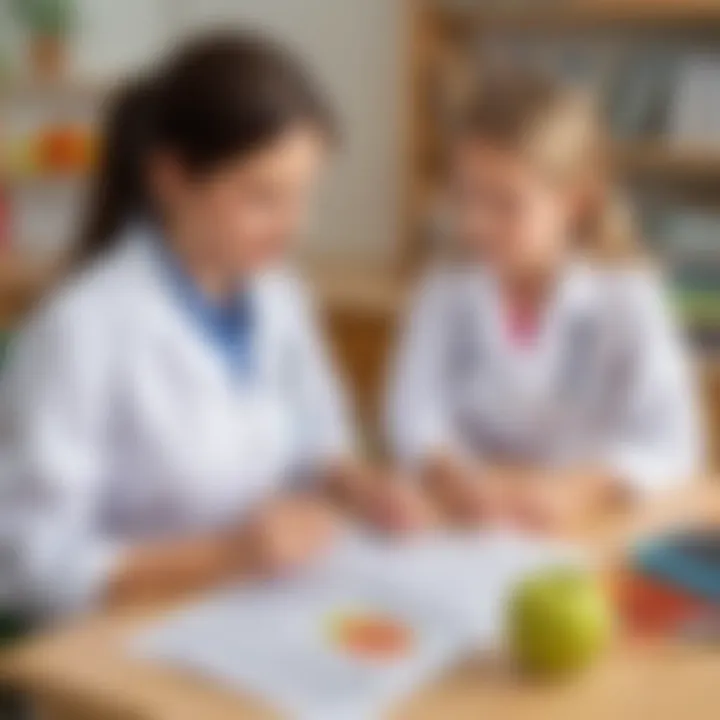Engaging Science and Health Lesson Plans for Kids


Intro
Science and health education is crucial for young learners. Engaging children aged 6-12 not only fuels their innate curiosity but also lays the foundation for critical thinking and informed decision-making. This article provides a comprehensive exploration into effective lesson plans tailored to capture the interest of young minds while instilling a strong understanding of essential scientific and health concepts.
The integration of hands-on activities, discussion prompts, and multimedia resources ensures that children remain engaged and motivated to learn. By nurturing an environment where inquiry is encouraged, educators and caregivers can cultivate a generation that appreciates the wonders of science and the importance of health in daily life.
Science Fun Facts
Fun facts can ignite a passion for science in young learners. Here are some engaging snippets:
- Did you know that a single teaspoon of honey represents the lifetime work of about 12 bees?
- Bananas are berries, but strawberries aren't. It’s true!
- The average person will produce enough saliva in their lifetime to fill two swimming pools.
Such intriguing facts can be incorporated into lesson plans to serve as conversation starters or to spark lively discussions. Incorporating trivia encourages young learners to think critically and ask their own questions about the world around them.
Interesting Trivia and Facts
Children often remember information better when it is presented in a fun and engaging way. Use these facts to promote curiosity:
- Octopuses have three hearts. Two pump blood to the gills, while the third pumps it to the body.
- A group of flamingos is called a 'flamboyance.' This can lead to discussions about animal behaviors and habitats.
Quirky Science Stories
Stories have a unique way of capturing attention. Share tales of scientific discoveries or the lives of famous scientists to make lessons more relatable. For example, one could discuss how Alexander Fleming accidentally discovered penicillin. This highlights the unpredictable nature of scientific research and how mistakes can lead to groundbreaking discoveries.
Amazing Science Records
Highlighting records can also enthrall young learners. Some records worth mentioning include:
- The largest snowflake ever recorded measured 15 inches wide.
- The fastest land animal, the cheetah, can run up to 75 miles per hour.
These records can lead to deeper explorations in biology, physics, and environmental science.
Thought-Provoking Questions
Encourage critical thinking by posing thought-provoking questions:
- If you could invent anything to help with health issues, what would it be?
- Why do you think some animals are endangered? What can we do to help?
Challenging students to think broadly enables them to engage with the material on a more personal level.
Discover the Wonders of Science
Understanding various scientific concepts is vital at this developmental stage. Lesson plans can introduce ideas through exploration, investigation, and experimentation.
Exploring Various Scientific Concepts
From basic biology to simple physics, each concept should be presented in a relatable manner. For instance, when discussing the water cycle, children could create a mini water cycle in a bag. This simple experiment can illustrate how water evaporates and condenses.
Educational Videos and Animations
Utilizing digital resources is essential in modern education. Websites like Britannica and YouTube offer a plethora of educational videos that simplify complex concepts. Exploring these resources encourages visual and auditory learners to thrive.
Interactive Learning Tools
Incorporate tools such as quizzes or apps that allow for active participation in learning. Websites like Kahoot can create competitive and engaging environments that make learning fun.
Real-Life Applications of Science
Connecting lessons to real-life scenarios enhances understanding. Discuss current events like climate change or health issues, and prompt discussions on their implications. Encouraging children to think about health practices in their daily lives can make the topic more relevant.
Science Quiz Time
Quizzes can be an engaging way to assess understanding and retention of information. Incorporate interactive elements for a more dynamic learning experience.
Interactive Quizzes
Use platforms like Quizlet or Kahoot to create science and health quizzes. This can transform assessment into a fun and engaging activity.
Multiple Choice Questions
Include questions such as:
- What gas do plants absorb?
- A) Oxygen
- B) Carbon Dioxide
- C) Nitrogen
- D) Helium
Brain Teasers and Puzzles
Stimulate problem-solving skills by incorporating brain teasers related to science or health. Simple puzzles can be excellent for critical thinking.
Learning Through Gamification
Involve games that promote scientific reasoning, such as science bingo or scavenger hunts centered on health and science themes. This active engagement fosters a love for learning.
Science Experiment Showcase
Experiments can serve as the backbone of science education, providing hands-on learning experiences.


Fun and Engaging Experiments
Introduce children to experiments such as making a homemade volcano with baking soda and vinegar. These experiments delight while teaching fundamental concepts in chemistry.
Step-by-Step Instructions
Provide clear, step-by-step instructions. For the volcano experiment:
- Gather materials: baking soda, vinegar, food coloring, and a container.
- Place baking soda in the container.
- Add food coloring for visual effect.
- Pour in vinegar and watch the reaction!
Materials List
Every experiment should come with a materials list to ensure everything is prepared. This could include:
- Baking soda
- Vinegar
- Container
- Food coloring (optional)
Safety Tips and Precautions
Safety is paramount. Always remind learners to wear safety goggles if necessary. Discuss why certain safety measures are essential, reinforcing good habits in science practice.
Engaging young learners through science and health lesson plans not only enhances their knowledge but also instills a lifelong love for learning.
This structured approach in designing lesson plans aims to provide enriching educational experiences that resonate with young learners.
Prologue to Science and Health Education
Science and health education is crucial during the formative years of childhood. It lays the groundwork for lifelong learning and fosters critical thinking skills. Educators recognize that early exposure to these subjects can shape a child's understanding of the world around them. The blend of scientific inquiry with health consciousness creates a comprehensive educational experience. This approach not only informs children about how things work but also empowers them to make better choices regarding their health.
Importance of Science and Health in Early Education
The significance of science and health in early education cannot be overstated. Children, at ages 6 to 12, are naturally curious and eager to explore. This curiosity can be harnessed to introduce fundamental concepts of science and health, enabling them to draw connections between lessons and real-life situations.
Key benefits include:
- Enhanced critical thinking: Children learn to ask questions, analyze information, and form conclusions based on evidence.
- Informed decision-making: Knowledge about health allows children to make informed choices about nutrition, exercise, and hygiene.
- Foundation for future studies: Early science education prepares students for more advanced topics in high school and beyond.
"Science education is not just about acquiring knowledge; it’s about learning to think critically and approach problems systematically."
Moreover, science and health education support the holistic development of children. By engaging them in hands-on activities, educators encourage exploration and experimentation. Such experiences build confidence and instill a love for learning that can last a lifetime.
This integrated approach also acknowledges that learning is multifaceted. Different children have varying preferences and capabilities. By addressing the diverse learning styles, educators can cultivate an environment that nurtures every child's potential.
Framework for Effective Lesson Plans
Creating effective lesson plans is crucial for young learners in science and health. This framework lays the groundwork for learning experiences that are engaging and educational. Having a structured approach ensures that teachers are prepared and students gain valuable knowledge.
Defining Learning Objectives
Learning objectives are built around what students should know and be able to do at the end of a lesson. Clearly defined objectives guide the teaching process. They serve several important purposes.
- Clarity: Objectives make it clear what is expected from students. Each objective provides focus to both teaching and assessment.
- Assessment: Well-crafted objectives aid in evaluating students' understanding and progress.
- Engagement: When learning objectives align with students’ interests, it fosters engagement. For instance, teaching about the human body can be linked to games or real-world applications that students find relatable.
Selecting Appropriate Content
Choosing the right content is essential for effective lesson plans. The content must align with age appropriateness and curriculum standards. It is important to consider a few factors:
- Relevance: Content should connect to students' lives or interests. This can include local health issues or scientific phenomena.
- Accuracy: Materials must be accurate and promote a clear understanding of the subject. Using reputable sources like Britannica or educational platforms can enhance the depth of the content.
- Diversity: Including diverse scientific topics can help cater to a wider range of curiosities. Topics can range from simple biology to more complex environmental science.
Incorporating Diverse Learning Styles
Recognizing that children learn in different ways is key. An effective framework accommodates various learning styles, allowing each child to engage fully.
- Visual learners may benefit from diagrams and videos that illustrate concepts clearly.
- Auditory learners might grasp material better through discussions or listening to stories related to scientific principles or health.
- Kinesthetic learners often excel in hands-on activities, such as experiments or group games, that allow them to physically engage with the material.
By considering these varying styles, educators can create an inclusive learning environment. Incorporating activities that cater to each style can lead to a richer understanding of science and health topics.
"An effective lesson plan includes clear objectives, relevant content, and diverse learning strategies tailored for young learners."
This framework for effective lesson plans is important in guiding educators. It supports the goal of making science and health education engaging for every child.
Engaging Activities in Science and Health Lessons
Engaging activities in science and health lessons are crucial for fostering a love for learning among young learners. Children aged 6 to 12 have boundless curiosity and energy, which can be effectively harnessed through interactive and stimulating experiences. Incorporating various activities keeps their attention and motivates them to explore scientific concepts and health knowledge. When lessons include engaging elements, children are more likely to retain information and develop a deeper understanding of the subject matter. Educators must carefully design these activities to cater to varied interests and learning styles.
Hands-on Experiments
Hands-on experiments are an excellent way to introduce young learners to scientific principles. Such activities allow children to experiment directly with various materials and observe outcomes in real-time. Examples include simple experiments like mixing vinegar and baking soda to observe a reaction. This kind of experimenting instills curiosity and improves problem-solving skills.
Moreover, working in small groups can cultivate teamwork. Children learn to communicate effectively and to respect diverse ideas. The excitement generated from successful experiments boosts confidence.
Consider the following when planning hands-on experiments:
- Safety First: Always prioritize safety by using age-appropriate materials.
- Clear Instructions: Provide simple, straightforward steps to avoid confusion.
- Set Goals: Clearly define the learning objectives of each experiment.
Experimenting doesn't just teach science; it enhances critical thinking.
Interactive Health Games


Interactive health games can be an effective method to teach children about health and wellness. These games can incorporate technology such as educational apps or traditional board games. Through play, children can learn about nutrition, exercise, and hygiene.
For instance, a scavenger hunt can encourage kids to find healthy food items or clues related to exercise. This turns learning into an adventure.
Key components for effective interactive health games include:
- Incorporation of Competitiveness: Kids enjoy a friendly competition that motivates them.
- Educational Value: Games should include facts that reinforce health concepts.
- Fun element: Keep it fun to encourage participation and retention of knowledge.
Field Trips and Nature Walks
Field trips and nature walks provide invaluable experiential learning opportunities. Visiting a local science museum or a health fair can reinforce classroom learning with real-world applications. Nature walks can serve as a platform for observing ecosystems, discussing biodiversity, and understanding environmental health.
When organizing these trips, it is important to consider:
- Relevance to Curriculum: Ensure the trip aligns with current learning topics.
- Preparation: Prepare students beforehand so they know what to expect.
- Follow-up Activities: Discuss findings and impressions after the trip to reinforce learning.
Integrating Technology into Lesson Plans
Integrating technology into lesson plans has become an essential aspect of modern education. For young learners aged 6-12, technology serves not only as a tool but also as a gateway to enhancing their science and health education. The importance of incorporating digital resources lies in the ability to engage students in ways that traditional methods may not. As children grow increasingly comfortable with technology, using it in educational settings helps to make lessons more relatable and interactive. Additionally, it provides access to a wealth of information and resources beyond what is available in physical classrooms.
Online Resources and Platforms
Online resources and platforms are critical for enhancing the learning experience. Websites such as National Geographic Kids and NASA’s Space Place offer age-appropriate content that fascinates children. These platforms provide videos, articles, and interactive activities that can complement lesson plans effectively.
Teachers can utilize these resources to access verified information, structured lesson plans, and teaching materials. When properly integrated, online resources can:
- Foster curiosity by presenting real-world applications of science.
- Facilitate independent exploration and discovery.
- Support visual and auditory learning styles through multimedia content.
Utilization of Educational Apps
Educational apps have transformed how children learn science and health concepts. Apps like Kahoot! and Labster encourage students to engage with material actively and collaborate with peers. The gamified elements make learning enjoyable while reinforcing critical ideas in a fun way.
When selecting apps, consider the following:
- Match content with educational goals and learning objectives.
- Evaluate user engagement and age appropriateness.
- Ensure apps promote critical thinking and problem-solving skills.
Virtual Science Experiments
Virtual science experiments allow children to engage in hands-on learning without the complexities or hazards associated with physical experiments. Programs such as PhET Interactive Simulations simulate scientific phenomena, providing a platform for safe exploration.
Here are some benefits of virtual experiments:
- Accessibility: Students can conduct experiments in a controlled environment at their own pace.
- Flexibility: Teachers can introduce complex topics without needing extensive setup or safety measures.
- Instant feedback: Many simulations provide real-time data, enhancing comprehension.
"Embracing technology in education not only prepares children for the future but also nurtures their innate desire to learn and explore the world around them."
Cross-Disciplinary Approaches
Cross-disciplinary approaches in science and health education serve as a powerful tool for enriching the learning experience for young learners. This strategy fosters a connection between different subjects, encouraging students to see the relationship between science, mathematics, art, and literature. By doing so, educators can cultivate a more integrated view of knowledge that reflects the interconnected nature of the real world. This is particularly vital for young learners aged 6-12 as it taps into their natural curiosity and desire to explore their surroundings.
Using cross-disciplinary techniques, teachers can reinforce concepts across varied subjects. Students often find it easier to understand complex scientific ideas when they relate them to measurable mathematical concepts. Moreover, engaging art and literature makes these concepts more relatable and enhances comprehension. The benefits of adopting cross-disciplinary approaches include improved student engagement, enhanced critical thinking skills, and a better retention of information.
Linking Science with Mathematics
Linking science with mathematics offers students opportunities to apply mathematical reasoning in practical contexts. This connection can be illustrated through experiments and projects where students collect data and analyze results. For example, measuring the height of plants in a science project allows learners to utilize addition, subtraction, multiplication, and basic statistics to present their findings. This not only deepens their understanding of both subjects but also demonstrates the application of mathematics in scientific inquiry.
- Benefits:
- Encourages problem-solving skills.
- Reinforces numerical concepts in real-life scenarios.
- Stimulates logical reasoning and analytical thinking.
It's important for educators to create lesson plans that include both subjects, emphasizing how they converge. Activity suggestions may include using graphing to represent scientific findings or predicting outcomes using mathematical models.
Integrating Art into Science Education
Integrating art into science education can make learning more engaging and enjoyable. Creative projects allow students to express their understanding through art, enhancing their emotional connection to the subject matter. Activities such as drawing scientific diagrams, designing posters for health-related topics, or crafting models of ecosystems can motivate students to invest more effort into their studies.
By tapping into their creative faculties, students often develop a better grasp of complex scientific ideas. Art projects can also emphasize themes like symmetry in biology or color theory in chemistry, establishing a visual link to scientific principles.
- Activities to Consider:
- Creating posters showcasing health benefits.
- Engaging in nature-inspired art projects.
- Building 3D models of DNA or cells.
Exploring the Relationship Between Science and Literature
The relationship between science and literature may not be immediately apparent, yet it plays a crucial role in developing a holistic understanding of scientific concepts. Incorporating literature enhances vocabulary while presenting scientific ideas within engaging narratives. Reading stories that incorporate scientific principles helps students visualize abstract concepts and may spark their interest in science.
- Considerations:
- Nature-themed stories encourage exploration and curiosity.
- Biographies of scientists inspire young minds.
By discussing books that highlight scientific themes or characters, educators can help students relate to scientists in meaningful ways. This combination of storytelling with science can turn challenging topics into engaging discussions, deepening comprehension and expanding interests.
"Cross-disciplinary approaches empower young learners to view knowledge as interconnected, enriching their educational experience in science and health."
Assessment and Evaluation Techniques
Assessment and evaluation techniques play a critical role in science and health education for young learners. Such techniques help educators gauge a child's understanding and interest in complex subjects. They serve as crucial indicators of learning progress, enabling educators to adjust their teaching methods accordingly. By employing a variety of assessment methods, teachers can receive a broader view of each student’s abilities and challenges, leading to more effective lesson plans.


In science and health education, it is essential that assessments are not solely focused on rote memorization. Instead, they should reflect actual understanding and application of the concepts taught. This multifaceted approach allows students to engage deeply with the material, ultimately fostering a more robust educational experience.
Formative Assessment Strategies
Formative assessments are ongoing evaluations conducted throughout the learning process. They help educators identify areas where students struggle. Common strategies include observational assessments, quizzes, and interactive discussions. Educators can ask prompt questions during class to gauge understanding. For example, while teaching about healthy eating, a simple question asking students to describe their favorite healthy food can yield insights into their comprehension.
Additionally, activities like group projects can offer opportunities for informal assessments. Teachers can observe teamwork, creativity, and engagement. Using checklists to track students’ progress on specific tasks can simplify the evaluative process.
Benefits of Formative Assessments:
- Immediate feedback allows for adjusted teaching.
- Encourages student reflection on their own learning.
- Fosters a dynamic classroom environment.
Summative Assessment Methods
Summative assessments evaluate student learning at the end of an instructional unit. They often take the form of tests or projects graded for overall mastery. In science education, a summative assessment can be a comprehensive project where students demonstrate their understanding. For example, creating a poster about body systems allows them to synthesize information.
These evaluations provide valuable data on how well students grasp the material, influencing future lesson plans. However, it is essential to ensure that the assessment format and expectations are clear. This clarity helps to prevent frustration and anxiety in young learners, leading to a more accurate assessment of their knowledge.
Summative Assessment Examples:
- Practical exams in a laboratory setting.
- Final projects presented to the class.
- Standardized tests aligned with curriculum goals.
Providing Constructive Feedback
Constructive feedback is essential in guiding young learners in their educational journey. When feedback is framed positively, it becomes a powerful tool for improvement. Emphasizing what a student did well, alongside areas that require enhancement, creates a balanced perspective.
Feedback should be specific, focusing on particular aspects of performance rather than general comments. For instance, instead of saying, "Good job!" a teacher might say, "You explained the process of photosynthesis clearly, but you could include more details about the light-dependent reactions."
Effective feedback encourages students to take ownership of their learning. Furthermore, it should encourage a growth mindset, motivating students to view challenges as opportunities rather than setbacks.
Key Aspects of Effective Feedback:
- Be timely. Provide feedback soon after the assessment.
- Be specific and focused.
- Encourage self-reflection by asking guiding questions.
Cultural Relevance in Science and Health Lessons
Cultural relevance in science and health education is crucial. It shapes how children perceive and engage with these subjects. When lessons are culturally relevant, they resonate with students. They see themselves and their contexts in the material. This connection promotes deeper understanding and retention of concepts.
Understanding diverse cultural backgrounds allows educators to adapt their teaching methods. Embracing cultural elements can foster inclusivity in the classroom. However, without acknowledging the cultural context, lessons may feel abstract or detached. This disconnection can result in disengagement. Recognizing and respecting diverse cultures encourages students to participate more actively.
Respecting Diverse Cultures
Respect for diverse cultures is a foundational aspect of effective education in science and health. Each child brings unique experiences and knowledge based on their upbringing and cultural context. Educators should aim to create a welcoming environment. This means using materials and examples that reflect various cultures. It helps all learners feel valued.
For example, when discussing health, it is beneficial to incorporate traditional practices. Many cultures have unique perspectives on health and wellness. Inviting guest speakers from different backgrounds can also enrich the learning experience. This inclusion can inspire students to share their traditions and learn from one another.
Incorporating Local Community Knowledge
Incorporating local community knowledge into lesson plans enhances their relevance. Community resources can provide tangible examples for scientific concepts. For instance, local ecosystems can be explored during biology lessons. This approach connects classroom learning to real-world environments. It also shows children the importance of their community in scientific discussions.
Additionally, local practitioners can serve as valuable resources. Health professionals from the area can illustrate the importance of community health initiatives. By engaging with the community, children gain practical insights. They learn about science and health in a way that is applicable and meaningful to them.
In summary, cultural relevance enriches science and health education. It fosters engagement and connection among learners.
Challenges in Designing Lesson Plans
Addressing Different Skill Levels
In a typical classroom, students come with different skill levels and learning capabilities. Some may grasp scientific concepts quickly, while others struggle. Therefore, it is essential to tailor lesson plans to accommodate these differences.
- Diagnostic Assessments: Begin with assessments to identify each student’s skills in science and health. This can guide differentiation efforts.
- Tiered Assignments: Offer assignments that vary in complexity. For instance, group students based on skills to complete projects suited to their level.
- Flexible Grouping: Change student groups for different tasks. This allows for peer teaching opportunities, enabling stronger students to help those who may lag behind.
Addressing skill levels not only supports learning but also builds confidence among all students. When learners see measurable progress, their motivation increases.
Engaging Reluctant Learners
Some students may show disinterest or reluctance towards science and health topics. For these learners, effective engagement strategies are vital. It's necessary to understand why these students resist participation. Often, disinterest stems from a lack of connection to the material.
- Relevance of Material: Incorporate real-life applications of science and health. Discuss how these subjects impact daily life and personal well-being.
- Interactive Learning: Use hands-on activities that allow students to explore concepts actively. Experiments or experiments that involve experimentation can often spark curiosity.
- Choice-Based Projects: Providing students with options in projects and assignments encourages autonomy. When they choose topics that interest them, engagement typically improves.
Engaging reluctant learners often requires patience and creativity. When their interest is piqued, their understanding and retention of concepts can significantly improve.
"Effective teaching must engage learners, not just inform them."
Culmination and Future Directions
Impact of Effective Science and Health Education
Effective science and health education has profound impacts on young learners. First, it stimulates critical thinking. Children learn to ask questions and explore answers rather than accept information at face value. This practice opens doors to inquiry-based learning, where students actively participate in their own education.
Moreover, such education promotes health literacy. By understanding health concepts, children can make informed decisions about their well-being. They learn about nutrition, exercise, and hygiene, which are vital for leading a healthy life. This knowledge not only benefits their current state but also sets a foundation for future healthy habits.
"A child who understands the value of health and science grows into an informed citizen who can contribute to society."
Incorporating engaging activities like hands-on experiments and interactive games further enhances retention and understanding. Simple experiments spark interest, while games make learning fun and memorable. These techniques are significant as they cater to different learning styles, ensuring that each child finds ways to connect with the material.
Fostering Lifelong Learning
Fostering lifelong learning is another crucial element of science and health education. When young learners are exposed to engaging lessons, they are more likely to develop an appreciation for learning itself. This attitude can propel them throughout their educational journey and into adulthood.
Developing lesson plans that emphasize exploration and encourage questions nurtures a mindset that values knowledge and inquiry. As these children grow, their foundational skills in science and health contribute not just to academic successes but to everyday choices in their personal lives.
Furthermore, the future directions of this educational approach should include adapting to advancements in technology and learning methods. Embracing innovations can keep the curriculum relevant and interesting, ensuring that children are excited and engaged in the learning process.
In summary, effective science and health education is more than just curriculum delivery; it is an essential tool for empowering young minds. By focusing on the principles discussed in this article, educators and caregivers alike can help children not only to understand science and health but also to appreciate the journey of learning itself.





